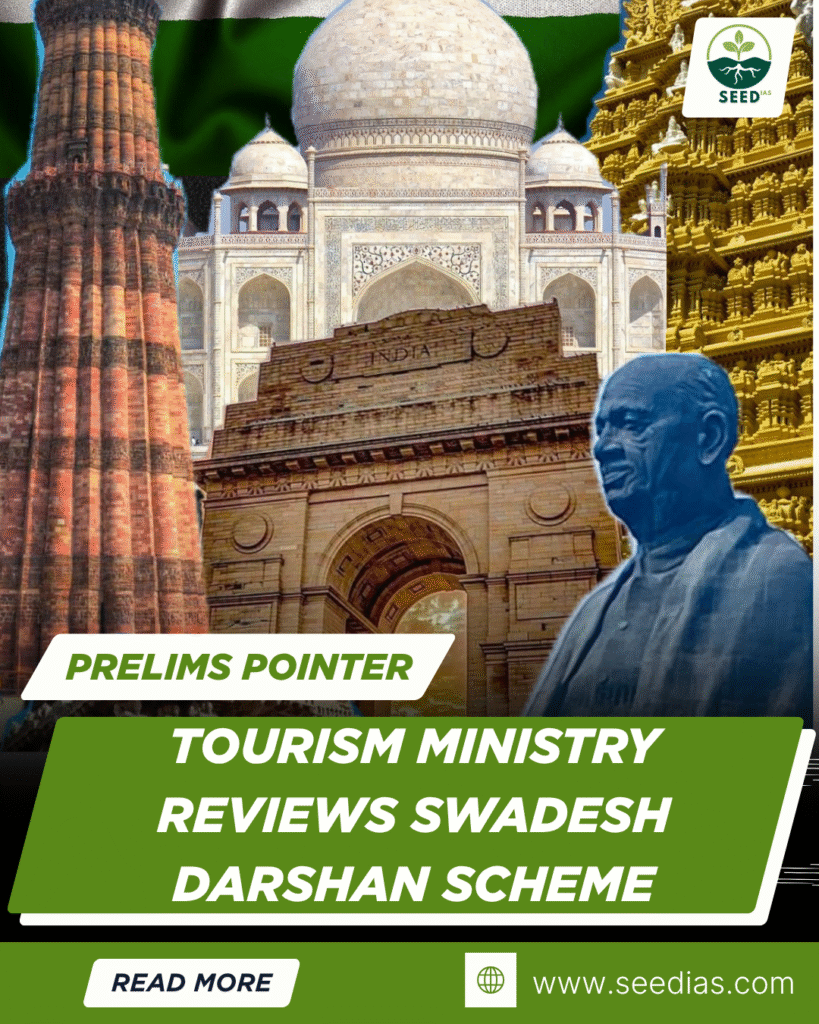Why in NEWS
The Ministry of Tourism has conducted a comprehensive review of the Swadesh Darshan Scheme (SDS) after the Comptroller and Auditor General’s (CAG) performance audit, focusing on institutional strengthening, data-driven destination selection, infrastructure benchmarking, and integration of hard and soft interventions for long-term sustainability.
Key Terms / Concepts
| Term / Concept | Explanation |
|---|---|
| Swadesh Darshan Scheme (SDS) | A 100% centrally funded scheme launched in 2014–15 for integrated development of theme-based tourism circuits to promote sustainable and responsible tourism. |
| Theme-Based Circuits | Specific tourism circuits developed around a theme, such as Buddhist Circuit, Heritage Circuit, etc. |
| Swadesh Darshan 2.0 (SD2.0) | A revamped destination-centric model focusing on sustainable tourism, local empowerment, and private sector participation. |
| Challenge-Based Destination Development (CBDD) | A competitive sub-scheme under SD2.0 emphasizing sustainability, digitalization, skill development, MSME support, and efficient management. |
| Hard Interventions | Physical infrastructure development in tourist destinations. |
| Soft Interventions | Capacity building, skill development, and promotional activities for tourism. |
Details
| Aspect | Information |
|---|---|
| Review Focus | Strengthening institutions, data-driven destination selection, infrastructure benchmarking, integrated hard-soft interventions, monitoring, sustainable operations, promotion, impact assessment. |
| SDS Launch | 2014–15, 100% centrally funded, supports States/UTs/Central Agencies. |
| Objectives | Integrated theme-based circuit development, sustainable and responsible tourism. |
| SD2.0 Shift | Destination-centric, aligned with ‘Vocal for Local’ and Aatmanirbhar Bharat, promotes private sector investment. |
| CBDD Model | Competitive approach for destination development focusing on sustainability, digitalization, skill development, MSME participation. |
| Long-Term Goals | Sustainable operations, enhanced tourist experience, employment generation, economic growth. |
Key Initiatives for Tourism Development
| Initiative | Objective |
|---|---|
| National Tourism Policy, 2022 | Strategic framework for sustainable and inclusive tourism growth. |
| Dekho Apna Desh | Campaign to encourage domestic tourism. |
| Ek Bharat Shreshtha Bharat | Cultural exchange to promote unity in diversity. |
| PRASAD Scheme | Development of pilgrimage and spiritual tourism infrastructure. |
| HRIDAY | Heritage City Development and Augmentation Yojana for heritage-based urban development. |
| Tribal Homestays under PM-JUGA | Promoting community-based tourism in tribal areas. |
| Capacity Building for Service Providers (CBSP) | Skill enhancement for better tourist services and employability. |
In a nutshell
SDS has evolved from theme-based circuit development to destination-focused sustainable tourism under SD2.0, integrating infrastructure with skill development, sustainability, and private sector participation.
Memory Code: “S-D-C”
S for Sustainable tourism
D for Destination-centric approach
C for Competitive CBDD model.
Prelims Practice Questions
- Which of the following is a sub-scheme under Swadesh Darshan 2.0?
A. PRASAD
B. CBDD
C. HRIDAY
D. Dekho Apna Desh - Swadesh Darshan Scheme is:
A. Centrally Sponsored Scheme with 50% funding from the Centre.
B. Central Sector Scheme with 100% funding from the Centre.
C. Public-Private Partnership Scheme.
D. State Government Scheme with central assistance. - Which of the following is NOT a focus area under Challenge-Based Destination Development (CBDD)?
A. Sustainability
B. Digitalization
C. MSME Support
D. Only heritage conservation without other facilities
















